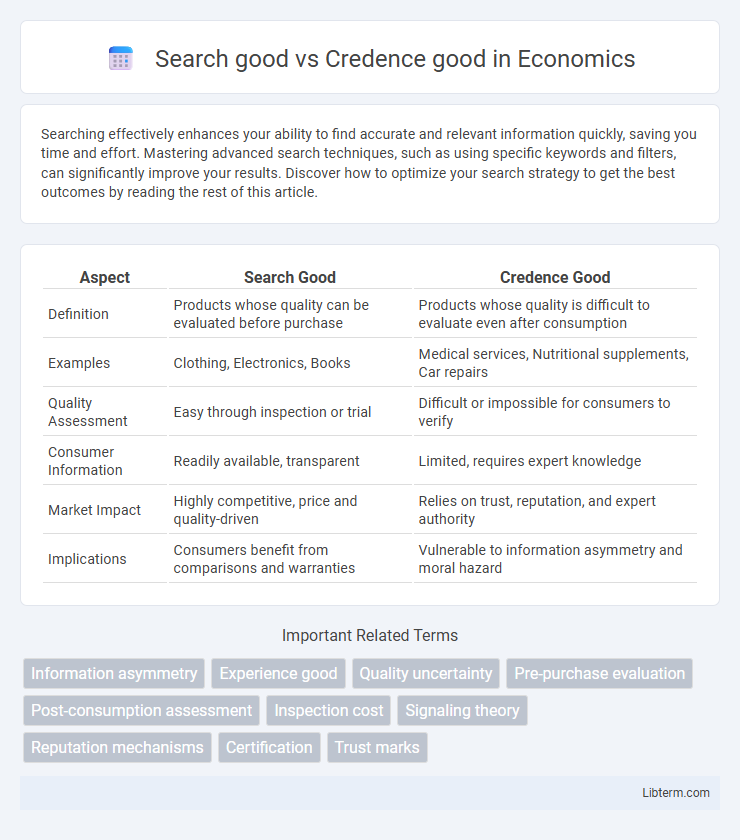Searching effectively enhances your ability to find accurate and relevant information quickly, saving you time and effort. Mastering advanced search techniques, such as using specific keywords and filters, can significantly improve your results. Discover how to optimize your search strategy to get the best outcomes by reading the rest of this article.
Table of Comparison
| Aspect | Search Good | Credence Good |
|---|---|---|
| Definition | Products whose quality can be evaluated before purchase | Products whose quality is difficult to evaluate even after consumption |
| Examples | Clothing, Electronics, Books | Medical services, Nutritional supplements, Car repairs |
| Quality Assessment | Easy through inspection or trial | Difficult or impossible for consumers to verify |
| Consumer Information | Readily available, transparent | Limited, requires expert knowledge |
| Market Impact | Highly competitive, price and quality-driven | Relies on trust, reputation, and expert authority |
| Implications | Consumers benefit from comparisons and warranties | Vulnerable to information asymmetry and moral hazard |
Understanding Search Goods and Credence Goods
Search goods are products or services with attributes easily evaluated before purchase, such as electronics with clear specifications and online reviews, enabling informed consumer decisions. Credence goods possess qualities difficult for consumers to assess even after consumption, like medical treatments or legal services, requiring trust in expert knowledge or certifications. Recognizing the distinction between search and credence goods is vital for marketing strategies, consumer behavior analysis, and regulatory policies ensuring transparency and quality assurance.
Key Differences Between Search Goods and Credence Goods
Search goods are products whose qualities and characteristics can be easily evaluated before purchase, such as electronics or clothing, allowing consumers to make informed decisions based on objective information. Credence goods, like medical treatments or legal services, are difficult or impossible for consumers to assess even after consumption, requiring trust in the provider's expertise. The key differences lie in the evaluation process and information asymmetry, with search goods offering verifiable attributes upfront, while credence goods depend heavily on professional credibility and consumer trust.
Characteristics of Search Goods
Search goods are characterized by attributes that consumers can evaluate prior to purchase, such as price, features, and quality, allowing for informed decision-making. These goods typically include electronics, clothing, and furniture, where product inspection is possible through reviews or direct examination. The transparency of information reduces uncertainty and increases buyer confidence in the purchase process.
Characteristics of Credence Goods
Credence goods possess unique characteristics that distinguish them from search goods, primarily because consumers cannot easily evaluate their quality even after consumption. These goods often require expert knowledge for assessment, such as medical treatments or legal services, where trust and reputation significantly influence purchasing decisions. The uncertainty and information asymmetry inherent in credence goods create challenges for consumer protection and market efficiency.
Consumer Decision-Making: Search vs. Credence Goods
Search goods enable consumers to evaluate quality and attributes before purchase through inspection or research, facilitating informed decision-making and reducing uncertainty. Credence goods, such as medical treatments or complex repairs, have qualities that remain difficult or impossible for consumers to verify even after consumption, requiring trust in expert opinions and certifications. This distinction impacts consumer behavior by increasing reliance on warranties, brand reputation, and expert advice when dealing with credence goods compared to more straightforward evaluation processes for search goods.
The Role of Information in Search and Credence Goods
Search goods allow consumers to evaluate quality before purchase through accessible information, enabling informed decision-making and reducing uncertainty. Credence goods, by contrast, rely heavily on trust since their quality or benefits are difficult to verify even after consumption, making information asymmetry a significant barrier. The role of information in credence goods centers on reputation, expert endorsements, and certifications to help bridge the knowledge gap between sellers and buyers.
Quality Assessment: Searchability vs. Trust
Search goods allow consumers to evaluate quality before purchase through direct inspection or information gathering, facilitating informed decision-making based on tangible attributes. Credence goods, however, pose challenges in quality assessment as consumers often lack the expertise or means to verify product efficacy even after use, relying heavily on trust, expert endorsements, or brand reputation. This fundamental difference in quality assessment impacts consumer behavior, marketing strategies, and regulatory policies surrounding these product types.
Marketing Strategies for Search Goods
Marketing strategies for search goods emphasize clear, detailed product information and transparent specifications to reduce consumer uncertainty. Providing comparison tools, customer reviews, and transparent pricing enhances consumer confidence and facilitates easier purchase decisions. Leveraging targeted advertising that highlights objective product attributes can effectively attract and convert buyers in search goods markets.
Marketing Approaches for Credence Goods
Marketing approaches for credence goods prioritize building trust and credibility through expert endorsements, detailed product information, and transparent customer testimonials because consumers cannot easily evaluate the product's quality even after purchase. Strategies often include leveraging certifications, promoting brand reputation, and providing extensive post-purchase support to overcome consumer uncertainty. Emphasizing emotional appeals and educating consumers about unique benefits helps differentiate credence goods in competitive markets.
Real-World Examples: Search Goods vs. Credence Goods
Search goods like electronics and clothing allow consumers to evaluate quality before purchase through specifications and reviews, ensuring informed decisions. Credence goods, such as medical treatments and legal services, require trust in expert knowledge because consumers cannot easily verify effectiveness even after use. Real-world examples highlight that online reviews and comparison tools enhance search goods transparency, while certification and reputation play critical roles in credence goods markets.
Search good Infographic

 libterm.com
libterm.com